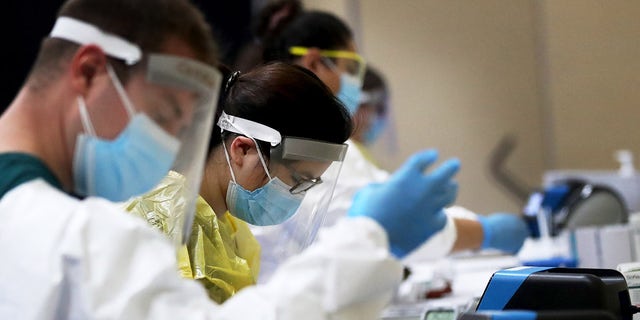The CDC significantly reduced its estimate for how prevalent the omicron variant of COVID-19 was in the United States earlier in December, saying on Tuesday that the omicron variant was responsible for 22.5% of all new cases for the week ending December 18 after previously saying the omicron variant was responsible for 73.2% of all new cases for the same week.
For the week ending Dec. 25, the agency says omicron accounted for 58.6% of all new cases.
Jasmine Reed, a spokesperson for the CDC, noted that there was “a wide predictive interval posted in last week’s chart,” and the downward revision was partly due to the “speed at which Omicron was increasing.”
“CDC’s models have a range, and… we’re still seeing steady increase in the proportion of Omicron,” Reed told Fox News Digital. “In some regions in the country, Omicron accounts for ~ 90% or more of cases.”

COVID antigen testers at UW-Eau Claire Monday in Eau Claire, WI. The test is for those who are asymptomatic and takes about 20 minutes from the time the swab is taken until the results come back. (Photo by David Joles/Star Tribune via Getty Images)
Dr. Jerome Adams, the former surgeon general in the Trump Administration, explained that the revision was likely partly due to a responder bias caused by a testing quirk with omicron called “S gene dropout,” in which one of the three target genes is not detected. When that gene is not detected, it can be an immediate marker for omicron.
“A lot of people were seeing this S dropout on the tests even before they got the follow-up genetic testing, and so those samples were disproportionately more likely to be sent in for sequencing,” Dr. Adams told Fox News Digital.
CDC SHORTENS ISOLATION, QUARANTINE PERIOD FOR COVID-19 INFECTED PATIENTS
As the CDC collects more data, they can more accurately pinpoint the proportions of each variant throughout the country, according to Dr. Li Tang, an associate faculty member in the Department of Biostatistics at St. Jude Children’s Research Hospital.
“Earlier, they probably relied on a small number of available sequences. It should be also noted, although the confidence interval now is narrower, the range is still big, covering from 41.5% to 74%, suggesting large uncertainty,” Dr. Tang told Fox News Digital.

Lurie Children’s hospital registered nurse Carolyn Ruyle prepares a dose of a Pfizer COVID-19 vaccine at Lurie Children’s hospital Friday, Nov. 5, 2021, in Chicago. (AP Photo/Nam Y. Huh)
The new estimates mean that the delta variant was still dominant for most of December, though omicron has a slight edge now.
Regardless, COVID-19 cases have been surging in recent weeks, as the United States set a single-day record for new cases on Monday with 441,278 confirmed infections.
The 7-day average on Monday was 240,408, which is roughly quadruple the low of 64,206 on Oct. 24.

Kecia Harris, with the environmental services department, cleans the room of a patient fighting the coronavirus at Our Lady of Angels Hospital in Bogalusa, La., Monday, August 9, 2021.
((Chris Granger/The Advocate via AP))
CLICK HERE TO GET THE FOX NEWS APP
Omicron was most prevalent in the South, the Pacific Northwest, the Midwest, and the New York area in the week that ended on Dec. 25, according to CDC data.
“It’s also important for people to understand that in the grand scheme of things, they really were probably just a week or two ahead of what we’re going to see anyway, because omicron is spreading so quickly that it is going to be 73% by the time you look at this week’s or next week’s numbers,” Dr. Adams said.